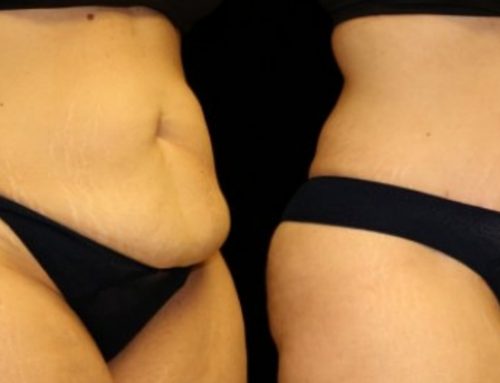If you are considering a tummy tuck, you might be wondering exactly what a tummy tuck is. When you “tuck” in your shirt, it’s not like your shirt tail disappears, is it? It’s still there, just hidden. Is that what happens with a tummy tuck? Is that extra pooch simply tucked in so it is hidden, like a good pair of Spanx?
Not really. Many people say tummy tuck in place of the technical term, abdominoplasty. Abdomino- refers to the abdomen, and –plasty refers to “molding, grafting, or formation of a specified part, especially a part of the body.” You see it in “rhinoplasty,” rhino- meaning nose, and in “angioplasty,” -angio meaning vessels.
So in a tummy tuck, the tummy isn’t just “tucked” in. The surgeon molds and forms the abdomen surgically to obtain a pleasing result for the patient. While the exact surgery an individual will require may vary, you can understand the basics about the procedure by considering a full tummy tuck.
Tummy Tuck Incision
First, your plastic surgeon will need to make an incision. Typically this will be oriented in a horizontal fashion above the pubic bone. It won’t necessarily be a straight line. The curvature and length of the incision will be determined by your specific anatomy, the amount of loose skin, and the location of any stretch marks you want removed.
Since the belly button doesn’t move and you want to keep it in the center of your abdomen even if it could, another incision is made around it. This frees the skin that surrounds the belly button so the excess skin can be removed in the next step. Modified or mini tummy tucks do not require an incision around the belly button; however, full tummy tucks do.
Tummy Tuck Modification
Next, excess skin and fat are cut away so that the abdomen is flat and tight when the upper of incision is pulled down to meet the lower incision. Another incision is made to allow your belly button to peek through the skin that is now covering it.
Tummy Tuck Closure
Once the excess removes excess skin and fat and puts everything is in its new, proper location, he sutures the two sides of the incision together.
Anytime an incision is made, the body’s natural response is to produce fluid to fill it. When the skin is repositioned as it is during a full tummy tuck, a space is created under that skin where fluid can accumulate. Traditionally a drain would be placed in that space. The patient would wear the drain for about a week until the natural healing process closed the space. But this is uncomfortable and increases the opportunity for infection.
With progressive tension sutures, the skin is sewn in place as it is pulled down, closing off the space where fluid might accumulate. This eliminates the need for a drain and speeds recovery.
Tummy Tuck Healing
A tummy tuck is major surgery. You will probably need to take about two weeks off of work and avoid physical exertion for four to six weeks.
There are things you can do to ease the process such as quit smoking, eat a well-balanced diet of whole foods, stay hydrated, and exercise regularly before surgery. These actions will go a long way toward easing your recovery. And after recovery they will help you maintain excellent surgical results.
Tummy Tuck “Extras”
Some patients will also benefit from tightening of their abdominal muscles because their “six-pack” has separated down the middle over time. Others will get the best results if liposuction is performed in conjunction with the tummy tuck. We will discuss these “extras” in later posts to give the full picture of what your surgery might include.
So, yes, there is a little more to a tummy tuck than just a “tuck.” But if you are unhappy with the appearance of your abdomen and exercise and diet aren’t getting the results you want, it may be a good choice for you.
Dr. Slack would like to consult with you in his Collin County office to discuss whether a tummy tuck can help you achieve your goals.





